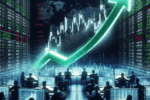Beijing, China — The Chinese garment industry is navigating unprecedented challenges as new tariffs reshape the landscape. These changes come amid an already complex recovery phase marked by shifting consumer sentiments and economic pressures.
China’s garment factories have increasingly felt the squeeze from rising import tariffs imposed by various countries. With the global textile market in flux, manufacturers are grappling with soaring costs while consumers’ tastes continue to evolve. Some industry experts warn that these factors could lead to a tipping point for many established textile producers.
The luxury sector is also experiencing turbulence as it tries to woo a disenchanted consumer base. After a period of unsustainable growth, brands are finding it difficult to regain the trust of shoppers, who are exercising restraint in their spending. The fragility of this recovery is underlined by the ongoing uncertainty surrounding trade policies, which can change with little notice.
In response to these challenges, many Chinese companies are rethinking their strategies. Some are investing in advanced technologies to streamline operations and reduce costs, while others are exploring new markets beyond traditional Western consumers. The need for innovation is highlighted by a growing demand for unique, high-quality products that resonate with customers seeking authenticity.
Simultaneously, brands are focusing on sustainability to appeal to a more environmentally conscious demographic. The push for eco-friendly practices is not merely a trend but a necessary adjustment in a marketplace increasingly influenced by social responsibility.
Amid these pressures, some companies remain optimistic. They note that adaptability has always been a hallmark of the Chinese garment sector. With a robust supply chain and a large workforce, there’s potential for resilience and recovery. Companies are hopeful that by embracing change, they can navigate through the current pressures and emerge stronger than before.
As the industry continues to evolve, stakeholders are closely monitoring the shifts in consumer behavior and global trade policies. The future is uncertain, but those within the industry are prepared to hustle harder than ever, leveraging their experience to find new avenues for growth in a challenging marketplace.










